Page 209 of 294
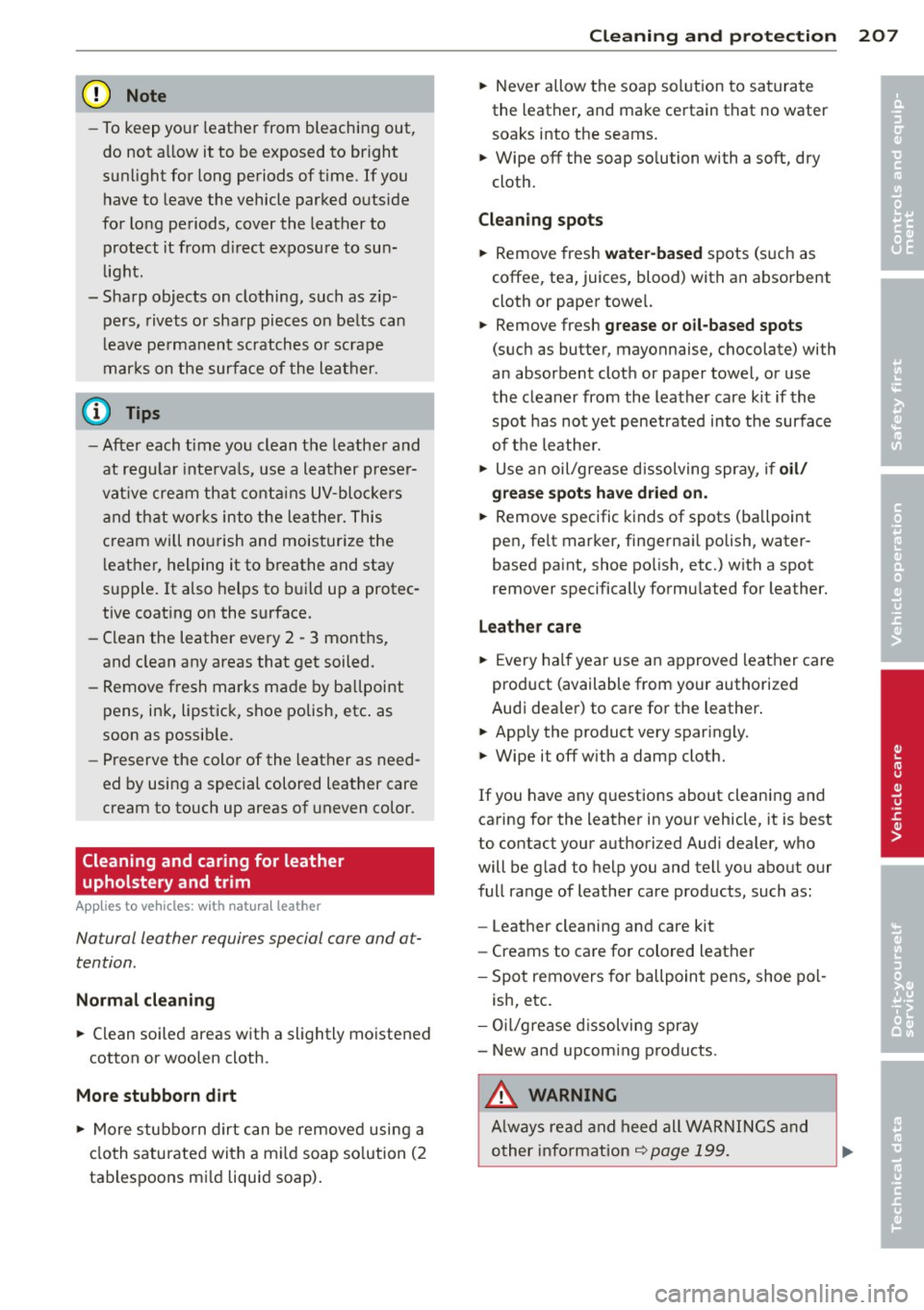
(D Note
-To keep your leathe r from bleaching out,
do not a llow it to be exposed to bright
sunlight for long periods of time. If you have to leave the vehicle parked outside
for long periods, cover the leather to protect it from d irect exposure to sun
l ight .
- Sharp objects on clothing, such as zip pers, rivets or sha rp pieces on belts can
l eave pe rmanent scratches o r scrape
mar ks on the surface of the leather.
@ Tips
- After each time you clean the leathe r and
at reg ular i nte rva ls, use a leather prese r
vat ive cream th at co ntains UV-blo ckers
and th at wor ks into the leather. This
cream will no urish and moistur ize the
l eather, helping it to breathe and stay
supple . It also helps to b uild up a protec
tive coat ing on the surface.
- Clean the leather every 2 - 3 months,
and clean any areas that get soiled.
- Remove fresh marks made by ba llpoint
pens, in k, lipst ick, shoe polish, etc . as
soon as possib le.
- Preserve the color of the leather as need
ed by using a special colored leather care
cream to touch up areas of uneven color.
Cleaning and caring for leather
upholstery and trim
Applies to vehicles: with natural leather
Natural leather requires special care and at
tention .
Normal cleaning
.,. Clean soiled areas w it h a slightly mo istened
cotton or woolen cloth.
More stubborn dirt
.,. More stubbo rn dirt can be removed using a
cl oth saturated with a m ild soap so lution ( 2
tablespoons mi ld liquid soap) .
Cleaning and protec tion 207
.,. Never allow the soap sol ution to sa turate
the leather, and make certain that no water
soaks into the seams .
.,. Wipe
off the soap so lution with a soft, dry
cloth.
Clean ing spots
.,. Remove fresh wate r-ba sed spots (such as
coffee, tea, juices, blood) with an absorbent
cloth or paper towel.
.,. Remove fresh
grease or oil -based spots
(such as butter, mayonnaise, chocolate) with
an absorbent clot h or pape r towel, or use
the cleaner from the leather care k it if the
spot has not yet penetrated into the surface
of t he leathe r.
.,. Use an oil/grease dissolving spray, if
oil /
grease spot s have dried on.
.,. Remove s pecific kinds of spots (ballpoint
pen, fe lt mar ker, fingernai l polish, water
based pa int, shoe po lish, etc.) with a spot
remover specifically formulated for leather.
Leather care
.,. Every ha lf year use an approved leather care
product (available from your authorized
Audi dea ler) to care for the leather .
.,. App ly the product very spar ingly.
.,. Wipe it
off with a damp cloth.
If you have any q uestions about cleaning and
caring for the leather in your vehicle, it is best
to contact your a uth orized Audi dea ler, who
will be g lad to help you and tell you about our
full range of leather care products, such as:
- Leather cleaning and care kit
- Creams to ca re fo r colored leather
- Spot removers for ballpoint pens, shoe pol-
ish, etc .
- Oil/grease d issolving spray
- New and upcom ing products .
_&. WARNING
Always read and heed all WAR NINGS and
other information
q page 199.
•
•
Page 210 of 294

208 Cleaning and protection
-Never use chemical solvents (e.g . lighter
fluid, turpentine), waxes, shoe polish or
similar products on the leather surfaces
in your Audi.
- To avoid damage, have stubborn stains removed by a commerc ial cleaning spe
cialist.
Cleaning Alcantara ® (synthetic suede)
App lies to vehicles: with A lcantara® up holstery
Removing dust and dirt
,. Moisten a cloth,
squeeze out excess water
and wipe down the seat surfaces .
Removing stains
,. Moisten a cloth with lukewarm water or
with diluted
ethyl (rubbing) alcohol.
,. Dab at the stain. Start at the outside and
work inwards .
,. Once the stain is no longer visible, use a
soft dry cloth or tissue to soak up the mois
ture.
Do not use leather cleaning products on Al
cantara ®.
You may use a suitable shampoo for removing
dust and dirt.
Dust and grit in the pores and seams can
scratch and damage the surface. If the car is
left standing in the sun for long periods, the
Alcantara ® should be protected against direct
sunlight to prevent it from fading . Slight color
variations will develop in normal use and are
not an indication of material deterioration .
IQ) Note
- Never use chemical solvents (e.g . lighter
fluid, turpentine), waxes, shoe polish or
s imilar products on Alcantara ® surfaces .
- To avoid damage, have stubborn stains
removed by a commerc ial cleaning spe
cialist.
- Do not use brushes, st iff sponges or sim
i larly abrasive cleaning aids . Safety belts
Only well-maintained safety belts work relia
bly when needed
.
,. Keep belts clean.
,. For cleaning, use a mild soap and water sol
ution. Let belts dry thorough ly and away
from d irect sunlight.
,. Do not allow inertia reel safety belts to re
tract before they are completely dry.
,. Check the condition of your safety be lts
reg
ularly.
Heavily soiled safety belts may not retract
properly.
A WARNING
-
Damaged safety belts can break in a crash .
- Anyth ing that might damage your safety
be lts could mean that you and your pas
sengers would not be adequate ly pro
tected in an accident.
- Safety belt performance depends on cor
rect installation. Never remove belts
from the vehicle to clean them.
- Do not use chemical cleaning agents,
bleach or dyes. They have corrosive prop
erties which weaken the webbing.
- When cleaning your safety be lts, inspect
them for damage . If you discover dam
age, see your authorized Audi dealer.
- Always read and heed all WARNINGS and
other information ¢
page 199.
Engine compartment
Be especially careful when cleaning the en
gine compartment.
Always switch off the ignition before clean
ing the engine
c.? .&, .
Plenum panel
Remove leaves from the plenum panel in front
of the windshield under the engine hood. This
prevents the water drai n holes from becoming
blocked, and it prevents debris from entering
the vehicle interior through the heating and
ventilat ion ducts .
Page 211 of 294

Corro sion prot ecti on
The engine compa rtment and transmiss ion
have been corrosion-protect ed at the factory.
Good ant i-corrosion treatment is very impor
tant , particularly in the winter. If the veh icle
is frequent ly driven on sa lt treated roads , the
enti re engine compartment and plenum panel
should be thoroughly cleaned at the end of
wint er and retreated to pr ev ent sa lt damage .
At the same time, the underside of the vehicle
should be washed as we ll.
If the engine compartment is cleaned at any
time with gr ease r emoving solutions
1l, or if
you have the engine washed, the anti-corro sion treatment is a lmost always removed as
well. It is therefore essential to have a long
lasting corrosion protection reapplied to all
surfaces, seams, joints and components in the
e ngine compartment .
.8, WARNING
Be aware: The engine compa rtment of any
motor vehicle is a po ten tially h azardous
area .
- Before working i n the engine compart
ment, be s ure to read the in format ion
Q page 215 .
-Be fore rea ching into the front plenum
pane l, always remove the ignition key .
Otherw ise, the windshield wiper system
cou ld uni ntentiona lly be switched on,
poss ibly causing personal injury from the
moving wiper linkage.
- Never reach into the area around or
touch the radiator fan. The auxiliary fan
is temperature controlled and can switch
on suddenly -even when the ig nition is
off .
- Do not wash, wax or dry the engine w ith
the engine running . Moving or hot parts
cou ld inju re you .
- Do not clean the underside of the chas
sis, fenders, wheel cove rs, or other hard
l ) Use o nly t he co rr ect clean in g s olu tio ns. Ne ve r use ga s
o line or d ie sel fuel.
Cleaning and protec tion 209
to reach parts without protecting your
hands and arms . You may cut yourself on
sharp-edged metal parts.
- Always read and heed a ll WARNINGS and
other information
Q page 199.
•
•
Page 212 of 294
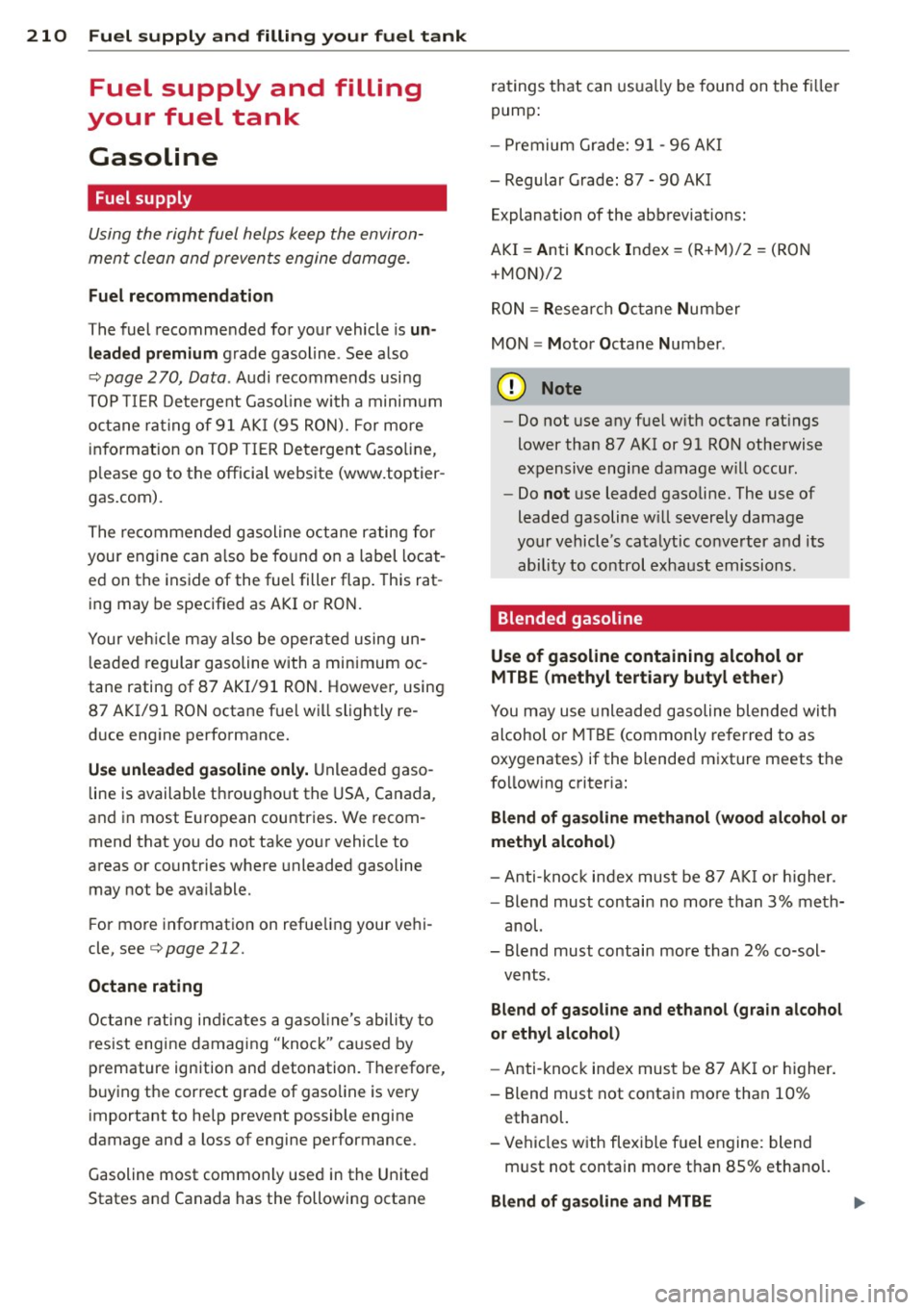
210 Fuel supply and filling your fuel tank
Fuel supply and filling
your fuel tank
Gasoline
Fuel supply
Using the righ t fuel helps keep the environ
ment cle an and preven ts engine dam age .
Fuel recommendation
The fuel recomme nded for you r vehicle is un
lead ed premium
g rade gasoline . See a lso
¢ pag e 270, Data . Audi recommends usi ng
T OP TIER D eterge nt Gaso line wi th a mini mu m
octa ne ra tin g of 9 1 AKI (95 RON). For more
in fo rmation on TO P TI ER De tergent Gaso line,
p lease go to the officia l webs ite (www.toptier
gas.com).
Th e re commended g asoline oct ane r ating for
your engine can a lso be fo und on a label loca t
e d on the ins ide of the fue l filler flap . This rat
ing may be specified as A KI or RO N.
Your veh icle m ay also be oper ated using un
l ea ded regular g asoline with a min imum o c
tane rating of 87 AKI/91 R ON. However, using
87 AKI/91 RON octa ne f ue l w ill slightly re
d uce eng ine perfo rmance.
Use unleaded gasoline only. Unleaded g aso
line is availab le th rou gho ut the USA, Canada ,
and in most E uropean countries . We recom
mend that you do not ta ke yo ur vehicle t o
areas or countries where unleaded gasoline
may not be avai lable.
F or mo re in format io n on refue ling your ve hi
cle, see
¢ page 212.
Octane rating
Octa ne r ating in dicates a gaso line's abili ty to
res ist engine damaging "knoc k" ca used by
p remature ign ition and detonation. Therefore,
buy ing the correct grade of gaso line is very
important to help prevent possible engine
damage and a loss of engine performance.
Gasoline most commonly used in the Unite d
States a nd Canada has the following octane r
at ings t hat can usu a lly be found on the fi ller
pump:
- Pre mium G ra de: 91 -9 6 A KI
- Regular Grade : 87 -90 AKI
Explanation of the abbreviations:
AKI = Anti K nock Index= (R+M) /2 = (RO N
+ MON)/2
R ON= Resea rch Octane Numb er
MON = Motor Octane Num ber .
(D Note
-Do not use a ny f ue l w it h octane rat ings
lower tha n 87 A KI or 9 1 RO N othe rwise
expensiv e engine damage w ill occur.
- Do
not use leaded gasoline . The use of
lead ed gasoline w ill severely damage
yo ur v ehicl e's catalytic co nve rter a nd its
ability to co ntrol exha ust em ission s.
Blended gasoline
Use of gasoline containing alcohol or
MTBE (methyl tertiary butyl ether)
You may use unleaded g asoline blende d with
alcohol o r MTBE (commonly re ferred to as
oxygenates) if the blende d mixture meets t he
f o llow ing criteria:
Blend of gasoline methanol (wood alcohol or
methyl alcohol)
- Anti -kno ck index mus t be 87 A KI or higher.
- Blend must contain no mor e than 3% me th-
anol.
- Blend must contain more than 2% co-sol-
ve nts .
Blend of gasoline and ethanol (grain alcohol
or ethyl alcohol)
- Anti -knoc k index must be 87 AKI or higher .
- Blend must not conta in mo re than 10%
ethanol.
- Ve hicl es w ith flexible f uel engine: blend
m ust not contain more t han 85% etha no l.
Blend of gasoline and MTBE .,.
Page 213 of 294

-Anti-knock index must be 87 AKI or higher.
- Blend must contain not more than 15%
MTBE.
Seasonally adjusted gasoline
Many gasoline grades are blended to perform
especially well for winter or summer driving. During seasonal change-over, we suggest that
you fill up at busy gas stations where the sea sonal adjustment is more likely to be made in
time.
CD Note
- Fuels containing a high percentage of
ethanol such as ESO and E85 may only
be used in vehicles with flexible fuel en
gines. Using high ethanol fuel in vehicles
not equipped with flexible fuel engines
can cause severe engine damage.
- Methanol fuels which do not meet these
requirements may cause corrosion and
damage to plastic and rubber compo
nents in the fuel system.
- Do not use fuels that fail to meet the
specified criteria in this chapter.
- If you are unable to determine whether
or not a particular fuel blend meets the
specifications, ask your service station or
its fuel supplier.
- Do not use fuel for which the contents
cannot be identified.
- Fuel system damage and performance
problems resulting from the use of fuels
different from those specified are not
the responsibility of Audi and are not
covered under the New Vehicle or the
Emission Control System Warranties.
- If you experience a loss of fuel economy
or driveability and performance prob
lems due to the use of one of these fuel
blends, we recommend that you switch
to unblended fuel.
Ethanol fuel (Bio-ethanol)
Applies to vehicles: with flexible fuel engine
Vehicles with flexible fuel engines may be op
erated with bio-ethanol fuels such as E85
Fuel supply and filling your fuel tank 211
(85% ethanol and 15% gasoline) or with un
leaded gasoline (91 AKI/ROZ 95). The vehicle
may also be operated with a mixture of these
fuels.
Your fuel consumption will increase when us
ing bio-ethanol fuels due to the lower amount
of energy contained per unit volume in etha
nol.
Warming up the Flexible fuel engine in low temperatures
Due to the chemical composition of bio-etha
nol, a certain amount of fuel ends up in the
engine oil when driving short distances in very
low temperatures . This fuel evaporates again
when the engine is warmed up .
II Please warm up engine.
If the driver message appears in the instru
ment cluster display, drive with a warm en
gine to reduce the oil level.
CD Note
- Never fill with methanol or with a higher
percentage of bio-ethanol than 85%
(E85). A higher percentage of bio-etha
nol in the fuel can cause damage to the
engine or to the fuel system.
- Read and follow the information and tips
about gasoline¢
page 210.
Gasoline additives
A major concern among many auto manufac
turers is carbon deposit build-up caused by
the type of gasoline you use .
Although gasoline grades differ from one manufacturer to another, they have certain
things in common . All gasoline grades contain
substances that can cause deposits to collect
on vital engine parts, such as fuel injectors
and intake valves. Although most gasoline brands include additives to keep engine and
fuel systems clean, they are not equally effec
tive.
Audi recommends using TOP TIER Detergent
Gasoline. For more information on TOP TIER ..,.
•
•
Page 214 of 294

212 Fuel supply and filling your fuel tank
Detergent Gasoline, please go to the official
websit e (www.toptiergas .com) .
After an extended period of using inadequate
fuels, built -up carbon deposits can rob your
engine of peak performance.
CD Note
Damage or malfunction due to poor fuel
quality is not covered by the Audi New Ve
hicle Limited Warranty.
Fuel tank
Fuel filler neck
The fuel filler neck is located on the right rear
side panel behind the fuel fi ller flap.
If the power locking system should fail, you
can st ill open the flap manually -for detailed
instructions see¢
page 214 .
You can find the fuel t ank ca pa city of your ve
hicle in
Technical Data¢ page 270.
The label on the inside of the fuel filler flap
tells you the correct fuel for your veh icle. For
more inform ation about fuel specifications,
see
¢page 210 .
Your vehicle fuel tank has an on-board refuel
ling vapor recovery system . This feature helps
to preven t fuel vapors from escaping from the
ta nk and polluting the environment while you
refuel your vehicle . In order to fill the tank
properly while protect ing the env ironment,
p lease follow this refueling procedure careful
l y .
& WARNING
Under normal operating conditions, never
carry add itiona l fuel containers in your car .
Gas canisters and other containers used to
transport fuel can be dangerous. Such con
tainers, full or empty, may leak and could
cause a f ire in a collision. If you must
transport fuel to use for your lawn mower,
snow blower, etc ., be very careful and al
ways observe local and state laws regard
ing the use, transportation and storage of such
fuel containers . Make certain the con
tainer meets industry standards (ANSI/
ASTM F852 -86).
CD Note
Never drive your vehicle until the fue l tank
is completely empty. The irregular supply
of fue l can cause misfir ing. Gasoline could
enter the exhaust system and damage the
catalytic converter .
Refuelling
Fig. 161 Righ t rea r v ehicle s ide: Opening th e fuel filler
flap
Fig . 16 2 Fuel fille r flap wit h at tac hed fuel ca p
When act ivat ing the central locking, the fuel
filler flap is automatically unlocked or locked.
Refuel the vehicle with the ignition turned
off.
Taking the fuel cap off
.,. Turn off the igni tion .
.,. Press the left side of the fuel filler f lap to
open it¢
fig. 161 -arrow -.
.,. Unscrew fue l cap counter-clockwise and
hang it on the fue l filler flap
¢ fig . 162.
Page 215 of 294
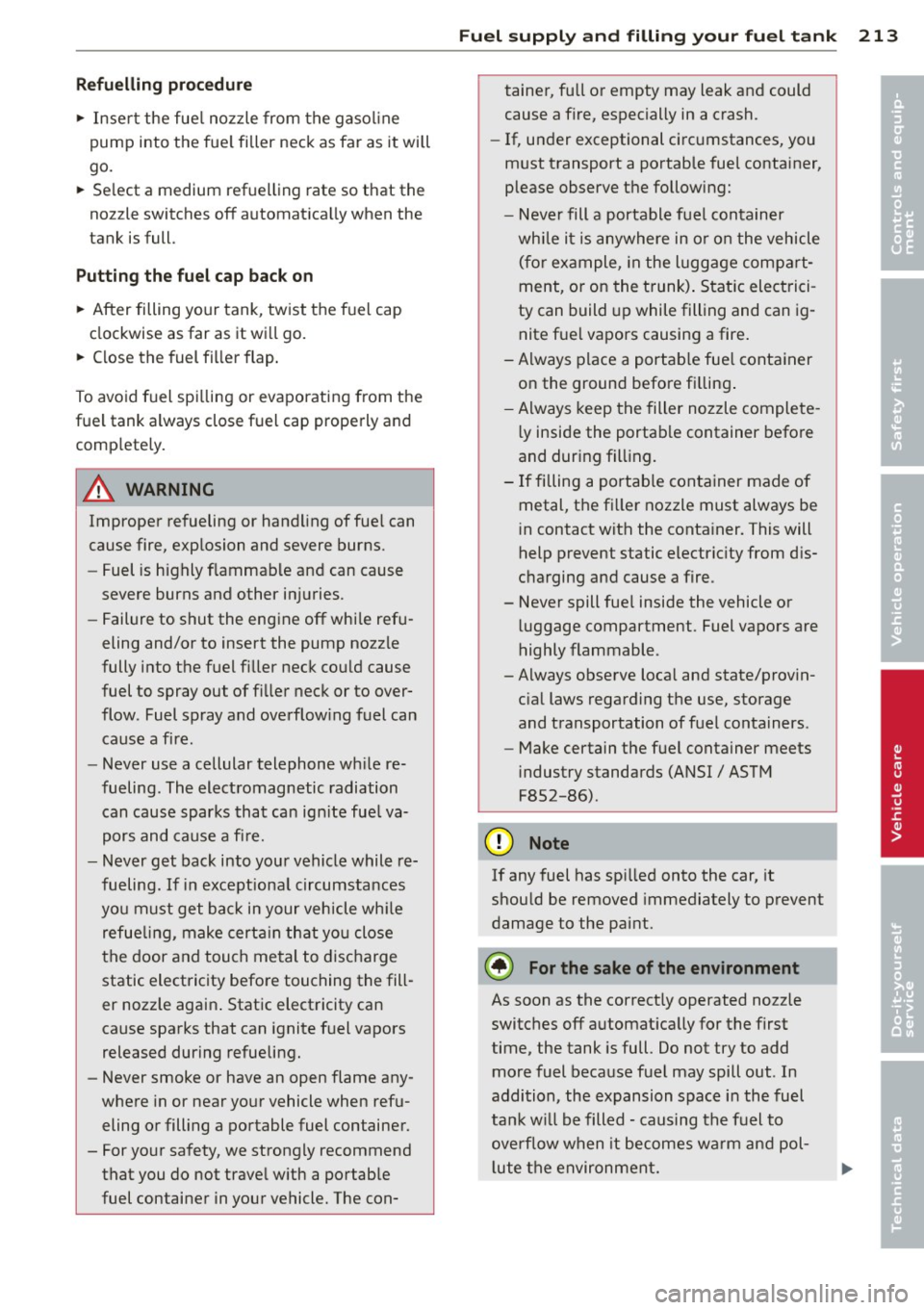
Refuelling procedure
"' Inse rt the fue l nozzle from the gasoline
pump into the fue l filler neck as far as it will
go.
"' Se lect a m edium refuelling rate so that the
noz zle switches off automatically when the
tank is full.
Putting the fuel cap back on
"' After filling your tank, twist the fuel cap
clockwise as far as it will go.
"' Close the fuel filler flap.
To avoid fuel spi lling or evaporating from the
fuel tank always close fuel cap properly and
comp letely.
A WARNING
Improper refueling or handling of fuel can
cause fire, explosion and severe burns.
- Fuel is highly flammable and can cause
severe burns and other injuries.
- Failure to shut the engine off while refu
eling and/or to insert the pump nozzle
fully into the fuel f iller neck could cause
fuel to spray out of filler neck or to over
flow. Fuel spray and overflow ing fuel can
cause a fire.
- Never use a cellular telephone wh ile re
fueling. The electromagnetic radiation
can cause sparks that can ign ite fue l va
pors and cause a fire.
- Never get back into your vehicle while re
fueling. If in exceptiona l circumstances
you must get back in your vehicle wh ile
refue ling, make certain that you close
the door and touch me tal to discharge
static electricity before touching the fill
er nozzle again . Static electricity can
cause sparks that can ignite fuel vapors
released during refueling.
- Never smoke or have an open flame any
where in or near your vehicle when refu
eling or filling a portable fuel container.
- For your safety, we strongly recommend
that you do not travel with a portable
fuel container in your vehicle. The con-
Fuel supply and filling your fuel tank 213
tainer, full or empty may leak and could
cause a fire, especially in a crash.
- If, under exceptional circumstances, you
must transport a portable fuel container,
please observe the following:
- Never fill a portable fuel container
while it is anywhere in or on the vehicle
(for example, in the luggage compart
ment, or on the trunk) . Static electrici
ty can build up while filling and can ig
nite fuel vapors causing a fire.
-Always place a portab le fue l container
on the ground before fi lling .
- Always keep the filler nozzle complete
l y inside the portab le container befo re
and during filling.
- If filling a portable container made of
metal, the fi ller nozzle must always be
in contact with the container. This will
help prevent static electricity from dis
charging and cause a fire .
- Never spill fuel inside the vehicle or
luggage compartment . Fuel vapors are
highly flammable .
-Always observe loca l and state/provin
cial laws regarding the use, storage
and transportation of fuel containers .
- Make certain the fuel container meets
industry standards (ANSI/ ASTM
F852-86) .
(D Note
If any fuel has spi lled onto the car, it
should be removed immediately to prevent
damage to the paint.
@ For the sake of the environment
As soon as the correct ly operated nozzle
switches off automat ically for the first
time, the tank is full. Do not try to add
more fuel because fuel may spill out . In
addition , the expansion space in the fuel
tank w ill be filled -causing the fuel to
overflow when it becomes warm and pol
l ute the environment. •
•
Page 216 of 294

214 Fuel supply and filling your fuel tank
@ Tips
-Running your engine while refuelling
may cause vapors to escape or even
cause fue l to spill out of the tank. This
would then shut off the fuel nozzle be
fore the tank is full.
- Do not refuel your vehicle w ith the igni
tion turned on. The fuel gauge may oth
erwise not ind icate the correct fuel level
after refuell ing.
- The fuel filler flap of your vehicle is not
locked when you lock the vehicle from
the inside.
Unlocking the fuel filler flap by hand
You can open the fuel filler flap by hand if the
power locking system should fail .
Fig. 163 Luggage compartme nt: opening the side tr im
Fig. 164 Luggage compartment: Emerge ncy open ing
of fuel filler flap
The emergency opening mechanism is located
behind the right side trim panel in the lug
gage compartment.
Opening the side trim
.,. Insert a too l such as a screwdriver
¢
page 251 or the emergency key into the
right side of the upper gap ¢
fig. 163.
.,. Pry upward to release the trim.
Fuel filler door emergency release
.,. Loosen the strap from its bracket and pull
on it ¢
fig. 164. You can now open the fuel
fi ller flap as usual¢
page 212.
 1
1 2
2 3
3 4
4 5
5 6
6 7
7 8
8 9
9 10
10 11
11 12
12 13
13 14
14 15
15 16
16 17
17 18
18 19
19 20
20 21
21 22
22 23
23 24
24 25
25 26
26 27
27 28
28 29
29 30
30 31
31 32
32 33
33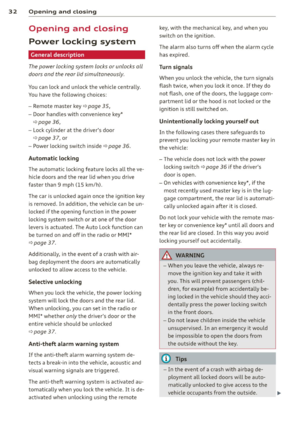 34
34 35
35 36
36 37
37 38
38 39
39 40
40 41
41 42
42 43
43 44
44 45
45 46
46 47
47 48
48 49
49 50
50 51
51 52
52 53
53 54
54 55
55 56
56 57
57 58
58 59
59 60
60 61
61 62
62 63
63 64
64 65
65 66
66 67
67 68
68 69
69 70
70 71
71 72
72 73
73 74
74 75
75 76
76 77
77 78
78 79
79 80
80 81
81 82
82 83
83 84
84 85
85 86
86 87
87 88
88 89
89 90
90 91
91 92
92 93
93 94
94 95
95 96
96 97
97 98
98 99
99 100
100 101
101 102
102 103
103 104
104 105
105 106
106 107
107 108
108 109
109 110
110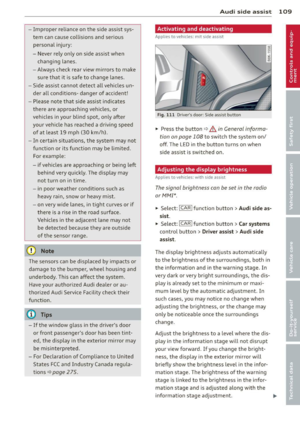 111
111 112
112 113
113 114
114 115
115 116
116 117
117 118
118 119
119 120
120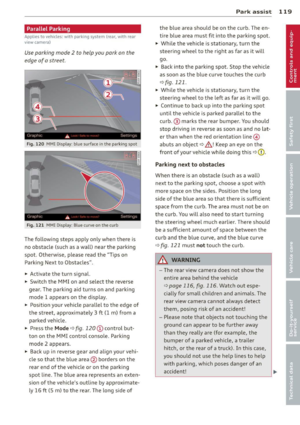 121
121 122
122 123
123 124
124 125
125 126
126 127
127 128
128 129
129 130
130 131
131 132
132 133
133 134
134 135
135 136
136 137
137 138
138 139
139 140
140 141
141 142
142 143
143 144
144 145
145 146
146 147
147 148
148 149
149 150
150 151
151 152
152 153
153 154
154 155
155 156
156 157
157 158
158 159
159 160
160 161
161 162
162 163
163 164
164 165
165 166
166 167
167 168
168 169
169 170
170 171
171 172
172 173
173 174
174 175
175 176
176 177
177 178
178 179
179 180
180 181
181 182
182 183
183 184
184 185
185 186
186 187
187 188
188 189
189 190
190 191
191 192
192 193
193 194
194 195
195 196
196 197
197 198
198 199
199 200
200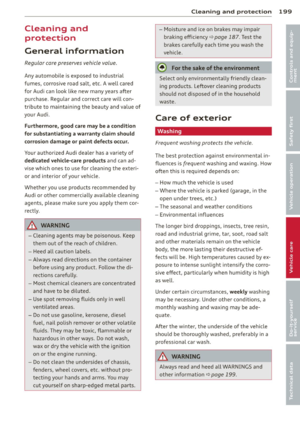 201
201 202
202 203
203 204
204 205
205 206
206 207
207 208
208 209
209 210
210 211
211 212
212 213
213 214
214 215
215 216
216 217
217 218
218 219
219 220
220 221
221 222
222 223
223 224
224 225
225 226
226 227
227 228
228 229
229 230
230 231
231 232
232 233
233 234
234 235
235 236
236 237
237 238
238 239
239 240
240 241
241 242
242 243
243 244
244 245
245 246
246 247
247 248
248 249
249 250
250 251
251 252
252 253
253 254
254 255
255 256
256 257
257 258
258 259
259 260
260 261
261 262
262 263
263 264
264 265
265 266
266 267
267 268
268 269
269 270
270 271
271 272
272 273
273 274
274 275
275 276
276 277
277 278
278 279
279 280
280 281
281 282
282 283
283 284
284 285
285 286
286 287
287 288
288 289
289 290
290 291
291 292
292 293
293






